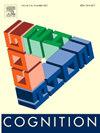The compositional nature of number concepts: Insights from number frequencies
IF 2.8
1区 心理学
Q1 PSYCHOLOGY, EXPERIMENTAL
引用次数: 0
Abstract
The frequency with which humans use words provides a window into the psychological representation of the corresponding concepts. Capitalizing on the availability of massive lexical databases, we evaluate the frequency with which specific number words and their combinations (e.g. “twenty-four”, “quatre-vingt-douze”) are used in six different languages. We use these data to probe the hypothesis that complex concepts arise as syntactic combinations of simpler ones in a language of thought. First, we confirm our previous report of a regular and reproducible profile of decrease in frequency with number size, with local peaks for round numbers. Second, we show that frequency varies with the simplicity of the decomposition of a number into small prime factors. Third, we demonstrate that the entire frequency profile, including its overall decrease and local peaks, can be modeled by a grammar of algebraic combinations, whereby each number arises from addition and multiplication operations on smaller numbers. Those findings strengthen the hypothesis that compositionality in a language of thought underlies the emergence of exact number concepts.
数字概念的组成性质:来自数字频率的见解
人类使用词汇的频率为研究相应概念的心理表征提供了一个窗口。利用大量词汇数据库的可用性,我们评估了特定数字单词及其组合(例如“二十四”,“四分之一”)在六种不同语言中的使用频率。我们使用这些数据来探索这样一个假设:在一种思维语言中,复杂的概念是由简单概念的句法组合而产生的。首先,我们证实了我们之前的报告,即频率随数字大小而下降的规律和可重复的轮廓,整数有局部峰值。其次,我们证明了频率随一个数分解成小质因数的简单性而变化。第三,我们证明了整个频率分布,包括其整体下降和局部峰值,可以通过代数组合语法建模,其中每个数字都来自较小数字的加法和乘法运算。这些发现加强了一种假设,即思维语言中的组合性是精确数字概念出现的基础。
本文章由计算机程序翻译,如有差异,请以英文原文为准。
求助全文
约1分钟内获得全文
求助全文
来源期刊

Cognition
PSYCHOLOGY, EXPERIMENTAL-
CiteScore
6.40
自引率
5.90%
发文量
283
期刊介绍:
Cognition is an international journal that publishes theoretical and experimental papers on the study of the mind. It covers a wide variety of subjects concerning all the different aspects of cognition, ranging from biological and experimental studies to formal analysis. Contributions from the fields of psychology, neuroscience, linguistics, computer science, mathematics, ethology and philosophy are welcome in this journal provided that they have some bearing on the functioning of the mind. In addition, the journal serves as a forum for discussion of social and political aspects of cognitive science.
 求助内容:
求助内容: 应助结果提醒方式:
应助结果提醒方式:


